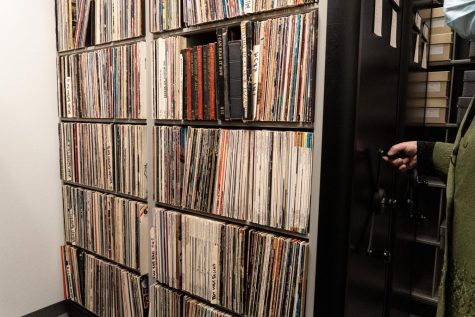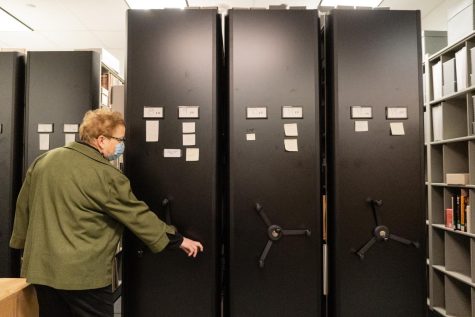Center for Black Music Research rebuilds after layoffs, COVID-19 shutdown
March 10, 2023

In the fall of 1983, musicologist Samuel A. Floyd Jr. laid out his vision for Columbia’s Center for Black Music Research. He wrote that the Center would be a one-of-a-kind library of materials related to music of the African diaspora, which would support academic publications and be accessible to scholars at Columbia and beyond.
Many of his plans came to fruition. The CBMR spawned national conferences and a performance ensemble, the Black Music Repertory ensemble. Until 2016, the Center published Black Music Research Journal, an academic journal with contributors from around the world.
Back then, the Center hosted a multitude of concerts, conferences and fellowships. Rami Gabriel, an associate professor in the Department of Humanities, History, and Social Sciences, was the Center’s final fellow.
“It was a very useful place to learn about those things [music artists] and to meet some scholars who also do this, it was both a place of scholarship and it was a community as well.” Gabriel said.
But staff layoffs and COVID-19 have since impacted the Center, which spans concert music, jazz, blues, ragtime, gospel and other genres—the essence of Chicago music.
In 2019, two staff members, including archivist Laurie Lee Moses, were terminated, and a reference librarian who worked at the Center resigned, as first reported by the Chronicle.
Now in its 40th year, the Center for Black Music Research, located in Columbia’s 618 S. Michigan building, is in “a period of transition,” Nathan Bakkum, senior associate provost who handles “strategic oversight” of the Center, said.
“I think we’re providing some really basic supports right now under current resources,” Bakkum, an associate professor in the Music Department, said. “And we’re looking to grow.”
Today, the Center is a special collection within Columbia College’s library. Although there is no dedicated staff working solely with it, three library staff members manage its archives and special collections, which includes all of the Center for Black Music Research. Archivist Heidi Marshall, recently hired manuscript archivist Amy Sherwood and digital archives specialist Dominic Rosetti work with the library’s collections.
Sherwood said that because of the amount of interest outside scholars show the Center, it gets a “larger chuck of our attention.”
The Center holds decades worth of materials, including vinyl, sheet music, videos and magazines. There are materials about Chicago-founded genres like House music, local figures like composer Florence Price, as well as global musicians.
“A lot of what we have is a really neglected part of history that, fortunately, is now becoming more of an interest to people on a larger scale,” said Sherwood. “But there’s a lot of amazing artists and composers back there [in the archives] that just don’t have the public profile.”
When the college shifted operations online at the beginning of the pandemic in 2020, the archive was opened remotely to field researcher requests, Marshall said.
“Many of the larger research institutions just weren’t open,” Marshall said. “So people were contacting us because we had put up these collection guides [online] and people knew we had material that might be of interest so they can actually continue their scholarship.”
However, there is still an appetite for the physical items. Marshall said that when students were allowed back into the Center, they loved interacting with the materials in person, and that visits to the Center have been “non-stop” lately.
With digitization there is, “a lot more equity in accessing collections,” Sherwood said. “Even if you can’t come here, you can still look at something on a remote appointment, that’s just not something that was available just a few years ago, anywhere.”
Though with over 100 collections held in the Center, digitizing with a small staff can be challenging.
“The collections that are associated with the Center for Black Music Research are delicate and fragile,” Bakkum said. “From wax cylinders, shellac discs and LPs to manuscripts, the process of making the materials available in the way that modern archives function digitally, is an incredible undertaking.”

Although the Center is an archive collection and preservation space for Black artwork, its staff, including Bakkum as oversight, currently consists only of white people. That is something the college is trying to address.
“I am trying to push beyond my own personal perspectives and my own personal biases in engaging with, hearing, understanding and representing the important work of Black musicians,” Bakkum said.
He said he is in the process of putting together a “strategic planning committee” for the center. “Going forward it’s important as we think about leadership of the Center for Black Music Research, that those questions of representation and diversity are at the core.”
Though library staff said they have not experienced any “interruption” in the amount of research requests they have received since 2019, the Center has witnessed less activity than what once was.
“It has not been accessible since the staff has been laid off,” Gabriel said. He and Associate Professor Robert Hanserd, whose academic focus centers around West African culture and history, created a series of events called Archive Alive. The programs included presentations about materials in the archives and discussions with artists, such as percussionist Chief Baba Neil Clarke. They hoped to “knock down the door” to shine a light on the archives in an accessible way.
The Center “strengthens your interaction with outside communities who do similar things,” Hanserd said. “Students can get interested and excited about using it, workshops and building better faculty connections can come from it. It’s just taking advantage of something that’s here and that’s already existing.”
Marshall said faculty are key to making students aware of the Center. “We have some very dedicated faculty who want to make sure that people come in and use the material, students in particular,” Marshall said.
Sophomore film and television major Madison Heiderscheit said she “had no clue” the Center existed, let alone that it was at Columbia until she took Gabriel’s “Listening to the City” class during the fall 2022 semester.
“At first I didn’t really want to go, but once I got there and we started going through archives, it was really interesting to see that Columbia has all of this rich history that should be in a museum,” Heiderscheit said.
Gabriel said if the college is committed to the Center, it needs to commit funding, too.
“We are committing to DEI and these things, and we feel that this place is at the center of a commitment to that, and it’s not being committed to in the way that these other programs are,” Gabriel said.
Funding for the Center has been supplemented in the form of large grants by the National Endowment for the Humanities in the past, but some of that funding “has not been sustained.” Bakkum said.
“In terms of building a long-term future for the Center, we know that we need to really lean into finding those sources of funding,” Bakkum said. “That might be grants through government agencies, private grants, [or] friends of the center who have means that are supportive of the mission.”
Future propositions for the Center, according to faculty and staff, involve increasing online accessibility, funding and building interest within communities.
“The Center has had multiple identities, and it has had multiple lives,” Bakkum said. “It has contributed to the field of Black music studies in a lot of different ways, and it continues to do so. The shape of that contribution is something that can take many forms and will absolutely be informed by the folks involved in that work and the researchers and musicians that we support.”







